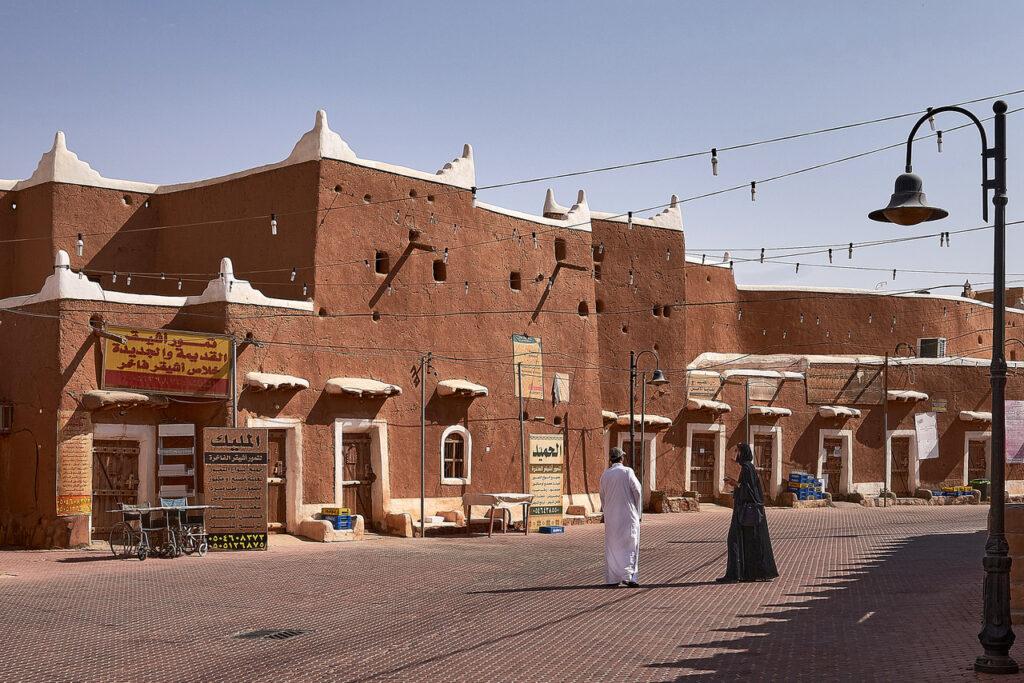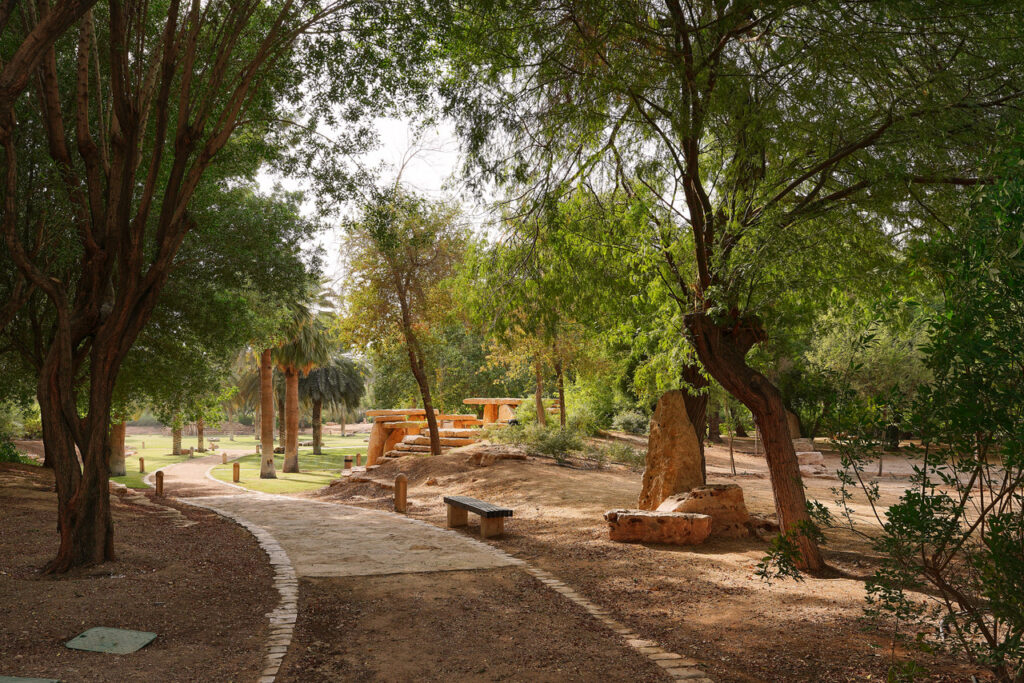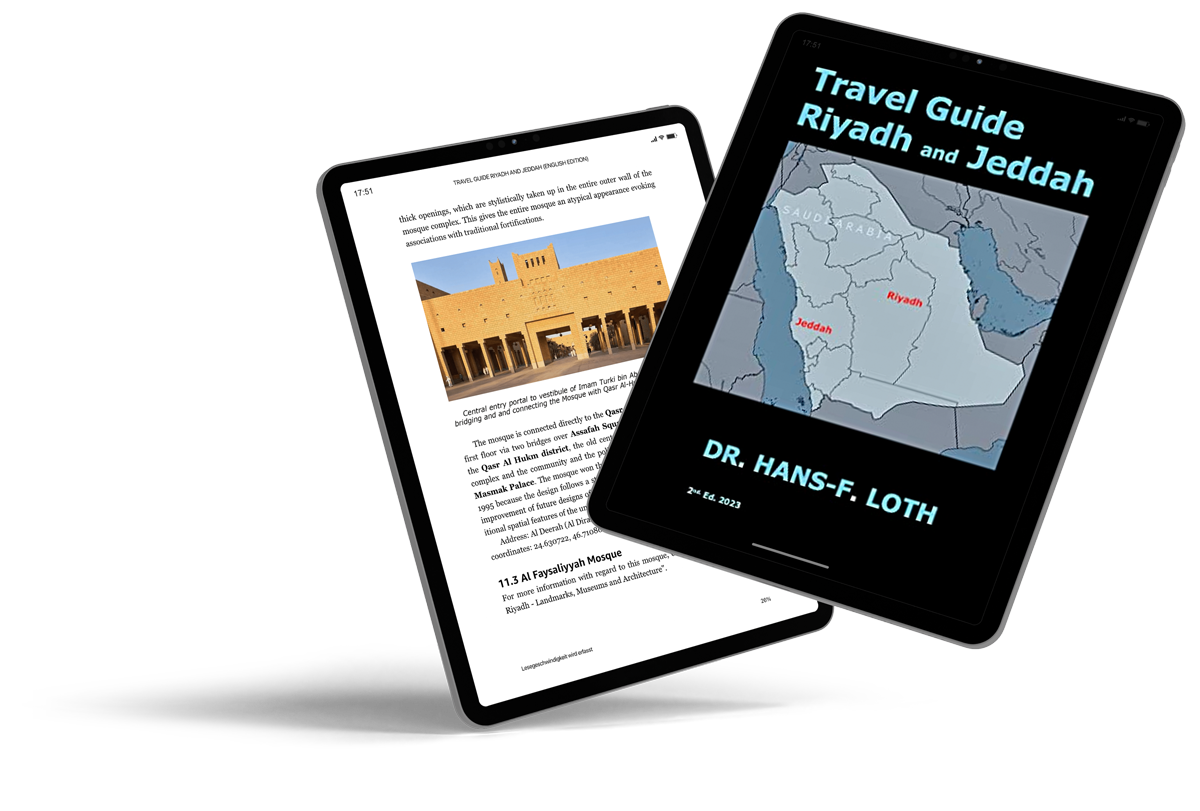Introductory Remarks
For reasons of space, this part of the blog must limit itself to a few separately presented architectural examples that are solitary in the truest sense of the word. The remaining examples of special architecture are addressed in the chapters dealing with their immanent function, so for example the Al Faysaliyyah Mosque in the chapter “Religious Life” or the National Museum in the chapter “Arts & Culture”. If you want to know more about the architecture of Riyadh and its history, I may refer you to my ebook „Dr. Hans-F. Loth – Travel Guide Riyadh and Jeddah“.
Although today’s Riyadh is a relatively young city, it has numerous architectural delights that would fill an opulent coffee table book to describe. Naturally, this blog cannot do that. In addition, many buildings cannot be visited purely for the purpose of seeing them, but can only be experienced in the context of fulfilling their function.
King Khaled International Airport
One example of that kind of building is the King Khaled International Airport complex, which opened in 1983 and was designed by the U.S. architectural firm Hellmuth, Obata and Kassabaum (HOK). Its clam-shell-shaped roof structure (as can be seen in the heading foto), for example, only becomes apparent to the passenger. Seen up close, the airport unfolds an intriguing mix of futuristic and traditional Islamic design concepts. The simple triangle is the predominant theme, and its extension leads to the hexagon. Both are fundamental shapes in the rich, complex patterns of traditional Islamic ornamental design. The airport’s passenger terminals, with their garden-style courtyards, are essentially triangular, and the roof panels are gently curving triangles resting on structural steel arches held together by triangular braces framing triangular window panes.
Riyadh Water Tower
As yet another example, the functionally rather mundane Water Tower is certainly not “glamorous” and is probably not very prominent with visitors for that reason alone. Nevertheless, the Water Tower, which dates from the end of the 1960s and the beginning of the 1970s and about which there is little to read apart from these dates, has a simple elegance with its striped pattern and the absence of any superfluous accessories, which is probably only to be found in a few water towers. The Water Tower is across the street from the National Museum in a park.
King Faisal Centre for Research and Islamic Studies.
Another example of contemporary architecture is this Al Faisal Foundation building. The overall complex (known as the Al-Khayriyya Complex) was designed in the early 1980s by Japanese architectural firm Kenzo Tange and houses the King Faisal Foundation. An office building, an apartment building, a shopping mall, an auditorium and a mosque are the main components of the entire complex. This is dominated by twin buildings of equal height, triangular in plan. The two buildings are arranged to form an imaginary open triangle, with the open side facing away from the busy King Fahd Road. At one of their apexes, the two buildings face each other and are connected there by two bridges, one above the other in the upper part. adjacent is the noteworthy Al Faysaliyyah Mosque (see the “Religious Life” chapter).
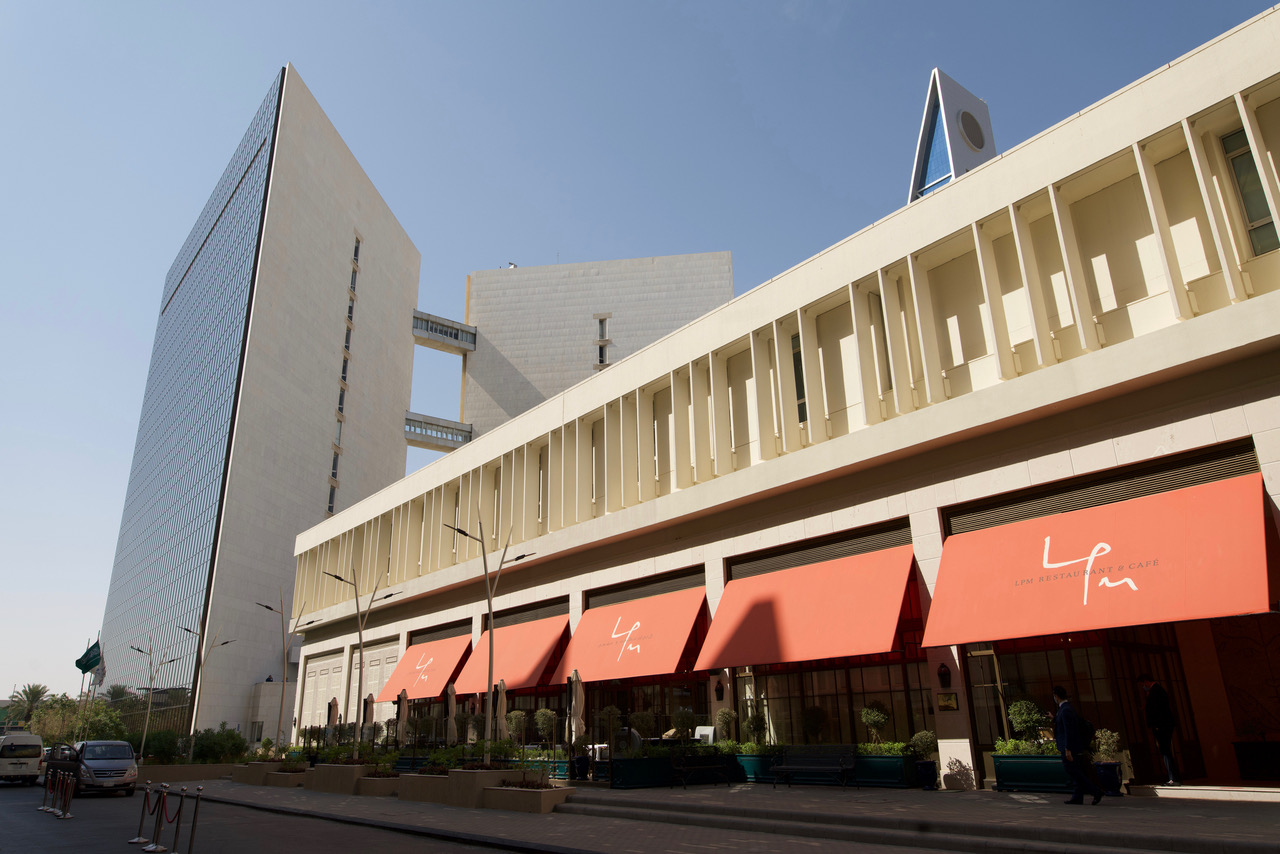
Al Faysaliyyah Tower
Right next to the King Faisal Foundation complex is another iconic and still noteworthy skyscraper, namely the impressive Al Faysaliyyah Tower ( برج الفيصلية) built in 2000, a 267 m tall business skyscraper designed by Norman Foster & Partners. The tower is an example of global-scale architectural development in the city, which is a marked departure from the tradition-oriented architecture of earlier times and indicates an intention to shape Riyadh into a modern metropolis. It is the first skyscraper built in Saudi Arabia and is also known as the Star Dome. Starting from a square ground plan, it converges at its top, comparable to an elongated pyramid.
Another notable element of the building is the monumental stained glass wall in the lobby, which references images from the desert and Riyadh’s Islamic culture and was designed by artist Brian Clarke. The tower has mixed use of offices, luxury apartments and a five-star hotel. The integrated sphere at the top of the Faysaliyyah Center houses a restaurant called “The Globe,” located about 200 meters above the ground and considered one of the best restaurants in Saudi Arabia. It offers diners a 360-degree view from which to watch the sunset over Riyadh, for example, which in itself makes the restaurant unique. It has a diameter of 24 m (79 ft) and consists of (allegedly) 655 glass panes. The golden globe is said to be inspired by a ballpoint pen.
Directly below “The Globe” is an observation deck that offers a magnificent panoramic view of the central spine of the city layout as well as the city’s street grid.
Address: King Fahd Road / Street No. 38; observation deck: open: 8:30 a.m.-5 p.m.; admission to observation deck: SAR 69 per adult (as of Nov. 2021).
The complex also includes the elegant three-story Al Faysaliyyah Centre shopping mall (see above), which directly adjoins the tower to the south.
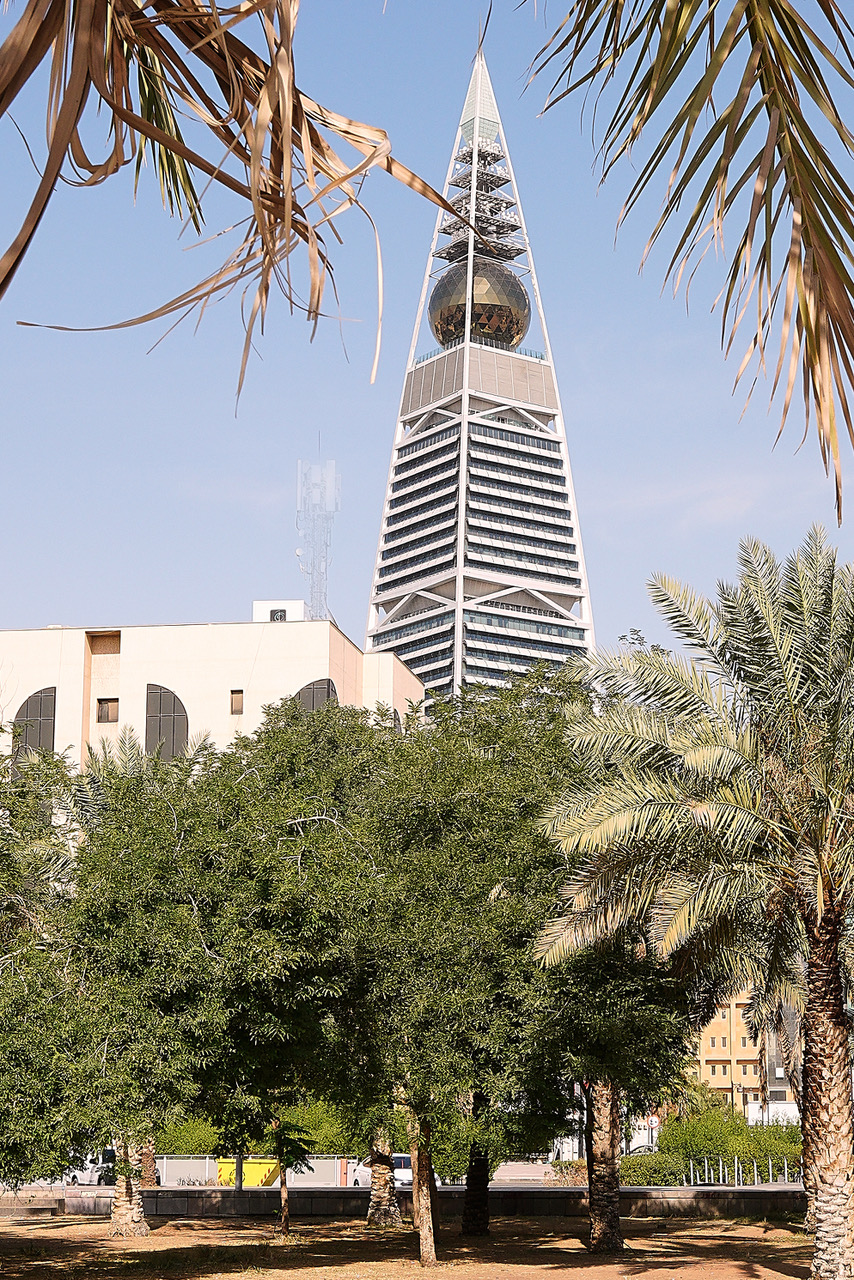
King Fahd National Library
South of the Al Faysaliyyah Tower, within sight and walking distance, is another notable structure, the King Fahd National Library. The library, redesigned by the architectural firm Gerber & Architekten, is cuboid in shape and its exterior façade is clad with textile membranes that follow traditional Middle Eastern architectural patterns on the one hand and combine them with state-of-the-art technology on the other. The white membranes serve as sun protection and reinterpret the Arabic tent building tradition. Above all, however, the cuboid shape of the new building is a kind of cocoon that encloses and also protects the original building on all sides, giving the impression that the National Library is a new architectural jewel in the cityscape without abandoning the old building.
Address: 6757 King Fahd Rd Al Olaya, Riyadh 12211, i.e. King Fahd Road / Olaya Street / Street No 26 / Street No 28;
Kingdom Tower
Easily accessible on foot via Olaya St. and about 2.90 km (1.8 mi) from Al Faysaliyyah Tower, the north-facing Kingdom Centre (مركز المملكة) is a 99-story, 302-meter skyscraper that is not only an iconic landmark for its “bottle opener” look, but also offers unforgettable, breathtaking views from the equally impressive so-called Sky Bridge at the top of the building.
The center was designed by Moraine & Associates. It is the third tallest “bottle-opening” building in the world after the Shanghai World Financial Centre and the 85 Sky Tower in Taiwan. The aforementioned sky bridge is 65 meters long and spans the entire width of the skyscraper at its highest point. It houses a public observation deck and offers visitors a remarkable view of the city of Riyadh. An elevator first takes visitors to the 77th floor-where the King Abdullah Mosque, the world’s highest mosque, is located-before transferring to a second elevator that takes them to the Sky Bridge on the 99th floor.
Address: King Fahd Road / Al Urban Road intersection, Riyadh 12341; +966 11 211 2222; Hours: Sky Bridge is open Sat to Thu from noon to 11 p.m. and Fri from 4 p.m. to 11 p.m.; Cost: SAR 69 (inc. VAT) per adult (as of Nov 2021).

